As a pet owner, seeing your dog have a seizure can be one of the most frightening experiences you’ll have. Seizures are often sudden, seemingly occur without reason and leave you feeling helpless as the owner.
There are a variety of different types of seizures in dogs. However, one very important type of dog seizure to be aware of is cluster seizures.
What are the types of seizures in dogs?
Unfortunately, there are actually several different types of seizures found in dogs, and they can vary greatly in severity. It’s valuable to be able to differentiate the different types of dog seizures so you can have an idea of what type of treatment and outcome to expect.
Epilepsy in Dogs
Believe it or not, epilepsy itself is actually NOT a type of seizure, rather a condition that often causes repeated bouts of seizures. The term “epilepsy” refers to recurrent seizures that originate in the brain. There are different forms of canine epilepsy as well, but again, these are not types of seizures themselves.
Grand Mal Seizures
In a generalized seizure, the dog will fall, lose consciousness, and extend his limbs out rigidly. The dog may also have sudden apnea, meaning he will briefly stop breathing. This will generally last for around 10 to 30 seconds. Afterwards, the dog will begin paddling his limbs or start chewing. He may also have dilated pupils, salivate, urinate or defecate.
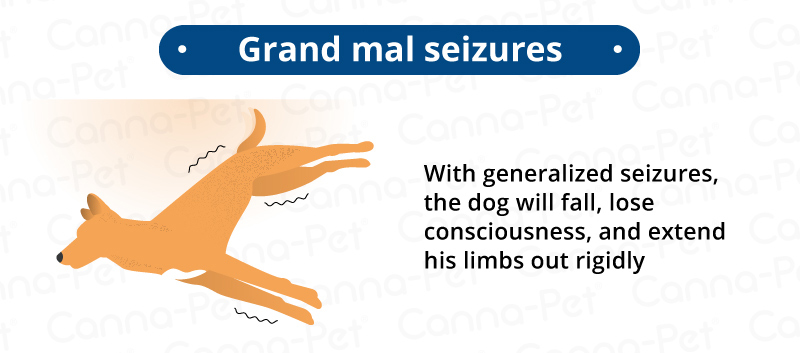
Mild Seizure
A mild seizure begins the same way as a grand mal seizure but will typically not involve the extension of the limbs or paddling. The dog usually will not lose consciousness. Mild and grand mal seizures are most often associated with epilepsy.
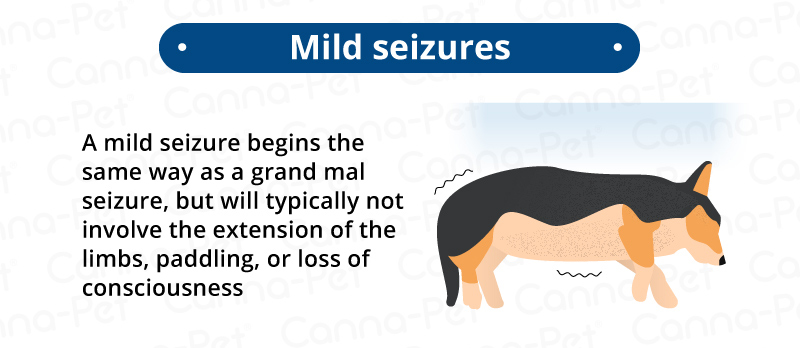
Petit Mal Seizure
Also known as an absence seizure, petit mal seizures are very rarely recognized in dogs. These seizures are very brief, lasting just seconds, and can manifest as a brief period of unconsciousness, loss of muscle tone, blank stare, or possibly even an upward rotation of the eyes.

Partial Seizure
During a partial seizure, the associated movements will only be seen in one area of the body. This can be the movement of one limb, a muscle jerking, a turning of the head or bending the trunk to one side or even facial twitches. Partial seizures can progress to generalized seizures and are associated with secondary epilepsy.
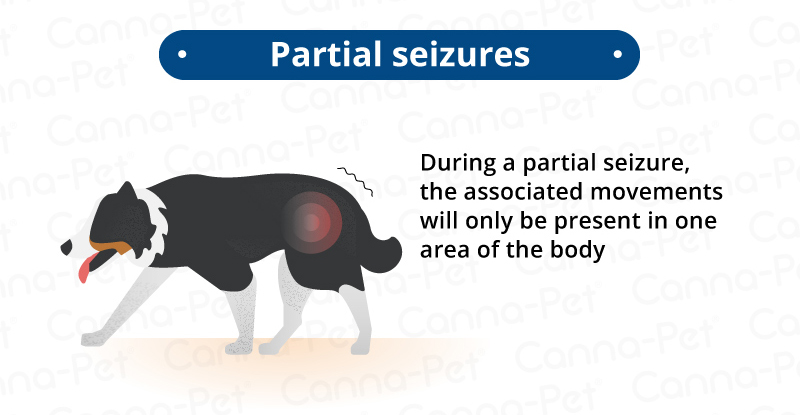
Complex Partial Seizures
These seizures are notable for the strange or complex behaviors that they repeatedly cause. In humans, complex partial seizures cause us to distort our thought perception, and certain emotions, like fear.
When they happen to dogs, they might be displayed as lip-smacking, chewing, fly biting, aggression, vocalization, frightened running, covering or hiding. Dogs may also experience vomiting, diarrhea, salivation, blindness, unusual thirst or appetite or biting.
These can last minutes or even hours, and can be followed by or progress to a generalized seizure. Like partial seizures, complex partial seizures are also closely associated with secondary epilepsy.

Status Epilepticus
Colloquially known as simply “status,” this type of dog seizure can occur either as a series of multiple seizures within a short timeframe with no periods of normal consciousness in between, or as one continuous seizure that can last up to 30 minutes.
Although closely related to primary and secondary epilepsy, status can sometimes occur suddenly in dogs that have no history of seizures or brain injury. Status can often be difficult to differentiate from cluster seizures. These seizures are considered life-threatening emergencies.
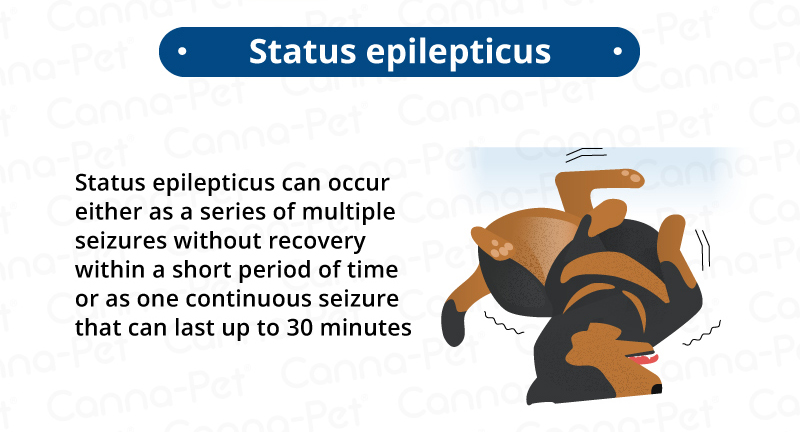
Cluster Seizures
Cluster seizures in dogs occur when a dog experiences multiple seizures within a short period of time, generally considered within a 24-hour window. Like status epilepticus, cluster seizures should be considered life threatening. These seizures are typically brief and isolated, but can also be more serious. Large breed dogs tend to be the most susceptible to cluster seizures.
When a dog experiences cluster seizures, he will usually have one, seem to recover, and then have another a few hours later. However, the dog never fully recovers from the first seizure before the second strikes. This can continue on and on until the dog is in critical condition. With the aforementioned status epilepticus, these seizures won’t be spread out, but will be one long seizure that doesn’t stop. Both are true emergencies.
Cluster seizures can be managed with medication, but the cause of the seizures must first be established before any medication can be prescribed.
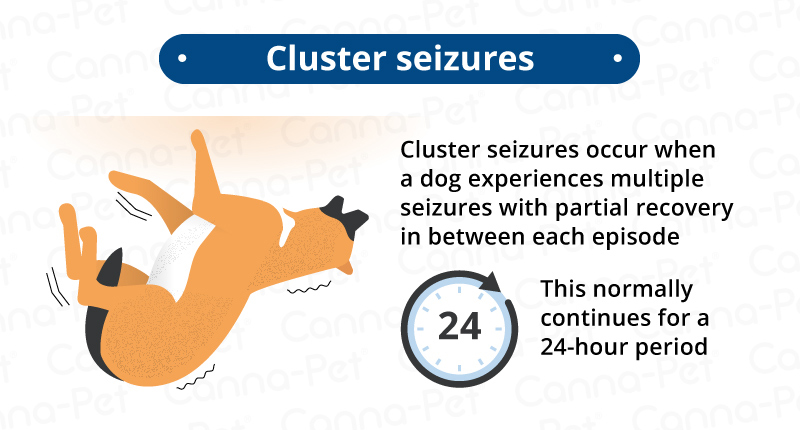
What causes cluster seizures in dogs?
Cluster seizures in dogs are often caused by a problem in the dog’s brain, such as a tumor that interferes with the communication between parts of the brain. They can also stem from a lack of oxygen in the brain, low glucose level in the blood, known as hypoglycemia, or hypothyroidism, which is a deficit of thyroid hormone production.
If the seizures seem to happen for no apparent reason, then idiopathic epilepsy may be the cause. This type of epilepsy is difficult to detect because it leaves no lesions or lasting damage on the brain. Genetics can also be a factor in dogs having seizures, but this is not yet absolutely proven.

What dogs have cluster seizures?
Any dog of any age and breed can experience cluster seizures, but they are most often seen in middle-aged dogs. Breeds like Border Collies, Cocker Spaniels, Dachshunds, German Shepherds, and Boxers are known to be susceptible. Research has actually shown that male dogs are more prone to cluster seizures than females.

What are the symptoms of seizures in dogs?
It’s important to note that most seizures are brief, and that your dog can live a normal life when given the proper dog seizure treatment. However, cluster seizures are much more serious, and can cause serious brain damage, or worse.
A dog experiencing a seizure will most often suddenly collapse, exhibit abnormal movement in its limbs, excessive drooling and uncontrollable jaw movement, as well as incontinence. The dog will usually be unconscious and unresponsive, and have no control over its spasms.
In cluster seizures, the dog will seem to recover between seizures, although he will be very tired and lethargic, potentially even staggering, as seizures are exhausting events.
Though their demeanor will otherwise seem fine, they do not fully recover in between seizures and can get progressively worse. If they don’t regain consciousness at all, or seem to have a prolonged seizure lasting up to 30 minutes, this is not a cluster seizure, but status epilepticus, which is extremely dangerous to your dog and can be life threatening.

How are cluster seizures diagnosed?
Dogs that have encountered cluster seizures should be brought into the veterinarian immediately. Once there, your vet will give your dog a glucose test. Often, your vet will also test to see if your dog has ingested poison.
A lot of the diagnosis will come down to what you are able to report to your vet when you bring your dog in. Pay attention to the symptoms your dog displayed during, before, and after a seizure. If you suspect cluster seizures, tell your veterinarian why and that will help them make a proper diagnosis.
Your vet may also conduct a CT scan or an MRI to see if there are any brain tumors or lesions. Since cluster seizures are so serious, you can expect a full round of testing.
How to Treat Cluster Seizures in Dogs
Medication will be prescribed by your veterinarian in order to treat a dog that is experiencing cluster seizures, but there are also a few things you can do at home to help care for your pet.
If you happen to notice your dog having a seizure, you can spring into action if necessary. Make sure your dog isn’t near anything sharp or close to stairs. Note your dog’s behavior during the seizure and, if possible, try to pinpoint the trigger. Comfort your dog after the seizure and see your vet immediately, especially if another seizure occurs.
If your dog has had cluster seizures, you should also be sure to monitor his other bodily functions. Things you’ll want to monitor include:
- Mental status and level of consciousness
- Breathing irregularities
- Heart rate and blood pressure
- Body temperature
- Salivation and fluid intake
- Muscle damage

Treating a dog with cluster seizures is emotionally stressful, and can be expensive, which is why pet owners will often choose to euthanize their pet. But if you want to keep your beloved dog living on, it will require treatment to quickly stop the seizure and provide support.
When you go into your veterinarian, he or she will most likely inject diazepam (valium) into your dog’s vein to quickly stop another seizure from occurring. After this initial dosage, vets most often recommend rectal diazepam for dogs with cluster seizures. Rectal diazepam is a generally safe method of home treatment and is the most popular treatment of cluster seizures because of their good track record for stopping seizures.
You typically would want to administer this treatment as soon as you can after the onset of a seizure. It can be repeated up to three times within 24-hours. However, if this is ineffective, your dog should be brought to your vet immediately for emergency treatment. The dosage will vary depending on the dog’s weight, age, breed, and more
Diazepam can only be acquired via a prescription from your veterinarian. Given the serious nature of cluster seizures, bring your dog in as soon as you can to put together a treatment plan with your vet. Additional hydration treatments may be recommended along with the rectal diazepam.
Overall, cluster seizures do not offer a great outlook for your dog, but can be managed by dedicated owners.
Sources:
- Yin, Sophia, “Vet Advice: Seizures in Dogs and Canine Epilepsy.” The Bark, 3 Feb. 2015, Accessed 1 April 2017. thebark.com/content/vet-advice-seizures-dogs-and-canine-epilepsy.
- “Cluster Seizures in Dogs.” VetInfo, Accessed 1 April 2017. www.vetinfo.com/cluster-seizures-dogs.html.
- “Epilepsy in Dogs.” The Kennel Club, Accessed 1 April 2017. www.thekennelclub.org.uk/health/for-owners/epilepsy/.
- Packer, R, “Risk Factors for Cluster Seizures in Canine Idiopathic Epilepsy.” Current Neurology and Neuroscience Reports, Apr. 2016, Accessed 1 April 2017. www.ncbi.nlm.nih.gov/pubmed/27033922.
- “Seizures and Convulsions in Dogs.” PetMD, Accessed 1 April 2017. www.petmd.com/dog/conditions/neurological/c_dg_seizures_convulsions.




